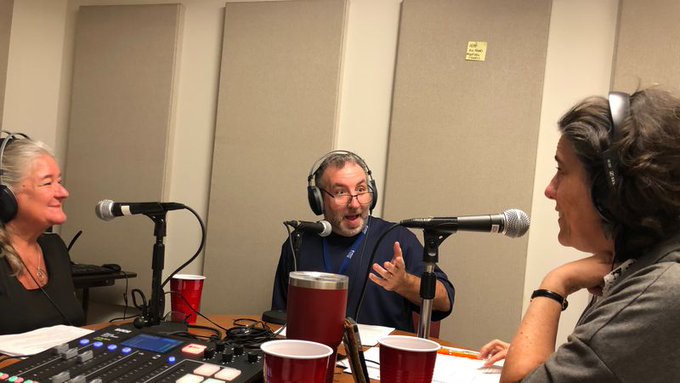I didn’t want to do this.
I wanted to make a podcast like Sarah Koenig’s “Serial,” or Chris Goffard’s “Dirty John.” I was working on this murder story and had killer audio. So my editor, Maria Carrillo, and I went to talk to our friends at Poynter to see if they could help.
But they had another idea. “You should do a podcast about writing, about craft,” someone suggested. “Talk about your stories and how you got them, dissect the process.”
Who would listen to that? I asked. And how many topics would there be? You mean a different episode every month?
No, said the Poynter people. If you’re going to do this, you have to do it every week. To build an audience, they said, you have to develop the habit in listeners. Make them want it. But don’t make them wait too long for the next episode.
So with no idea how to make a podcast, much less produce and disseminate it, we dove in. Danese Kenon, then a video editor at the Times, was happy for the challenge and became the producer. Our boss liked the idea, especially since it wouldn’t cost anything but our time. Go ahead, she told us. Give it a shot.
WriteLane launched in December 2017, with an episode about my Pulitzer-prize winning story The Girl in the Window. Last week, we invited Poynter media guru Tom Jones to join us, and aired Movies about us. Our 100th episode!
We still don’t have a budget. My mom drew the logo. My husband wrote and recorded the music. But once a month, Maria and I head up to the hot and windowless studio on the floor above the newsroom and spend a couple of hours recording four episodes at a time.
The show drops on Wednesday mornings and is free on several platforms, including iTunes. On the Tampa Bay Times website, we include links to tip sheets and stories. WriteLane episodes usually run about 20 minutes. “Just enough time for me to walk my dog,” one journalism professor wrote.
[the_ad id=“667826”]
Maria and I talk about finding story ideas, interviewing, taking notes, writing leads and endings and everything in between. We share advice, angst and inspiration. And we read some of our favorite stories. We examine where they came from, what worked, what didn’t. We bring in colleagues and other journalists from around the world. We have had guests from Russia, New Zealand and Denmark. We recorded podcasts in Norway, including one with Andy Mills, who helped create The New York Times’ podcast “The Daily.”
We have done episodes about People in the Shadows, why to go into journalism and how to get a job. We told a ghost story, shared regrets and convinced each other that, “we don’t suck that bad.” And we’ve had some of our favorite teachers from Poynter: Jacqui Banaszynski of the Nieman Storyboard, Seven paths to story; Chip Scanlan of Chip on Your Shoulder, Nut graph or no nut graph?; and Jan Winburn, who edited narratives for CNN, with Insert yourself?
Our conversations are casual and fun, produced in turn over the years by photographers Monica Herndon and Martha Asencio-Rhine.
Listeners in over 40 countries have downloaded the podcast more than 50,000 times. And since most topics are evergreens, folks often come back to the older episodes. I’m surprised so many people are listening out there, from as far away as Scotland and South Africa.
I’m even more shocked at the feedback we have gotten from loyal listeners. High school teachers and college professors assign the podcast to their students. Metro editors and sports writers listen in their newsrooms. Young journalists who can’t afford to go to conferences, and who aren’t getting training, and who don’t really get to talk about the process — and terror — of writing share our episodes and write lovely emails. They keep us going.
[the_ad id=“667872″]
What have we learned?
There is an appetite for how-to podcasts. They don’t have to be true crime or high drama. They don’t need special effects. People like hearing stories — and backstories. And they want to learn.
Sometimes it’s OK to jump in and find your way. The episodes have improved over time. And the whole process has gotten easier, from writing scripts to being comfortable in front of a microphone.
Talk about what you know. We don’t do a lot of research for these podcasts. We use talks we have given at conferences, stories our colleagues have written, conversations we’ve had in our newsroom and insights we have gleaned over more than 30 years of daily journalism.
Trying something new is scary but also exhilarating. So what if no one had listened? We would have put the idea on a shelf and moved on. Now, in our 50s, we’ve got new skills and an entirely new audience.
Ask for help. Our colleagues and friends have been so generous with their time. Our listeners have chimed in with ideas for episodes.
Could you do this without a producer? Yes, and one of our education reporters, Jeff Solochek, does a nice job with the Gradebook podcast, handling most everything by himself. But we feel really grateful to have had such amazing producers. They are our sounding boards and first critics, which is super helpful.
Don’t sweat it like you do a story you’re about to publish. We curse sometimes, we cough and sneeze, we say the wrong thing. But we want it to feel like a conversation, over drinks, in your living room. If it’s too perfect, it just wouldn’t feel right.
It’d be smart to make money from this. We’re just now getting to a place where we’ll have some programmatic advertising. And we’ll be announcing our first short-term sponsor early next year.
It would have been great to have had that in place when we started. But it would have been hard to sell the idea without a product. So almost two years later, we’ll finally make a small amount of money for the paper.
[the_ad id=“667878”]
So thank you, Poynter, for pushing us to podcast. Thanks to those of you who have listened and taken the time to write. It helps so much to know someone is getting something out of it. And amazingly, we haven’t run out of things to talk about.
Oh, and that murder story I wanted to turn into a podcast? We finally did an episode on that: The House on the Corner.
Then the story got picked up by NPR and became an episode on one of their podcasts, Code Switch.
Careful what you wish for …
If you have an idea for an episode of WriteLane, or want to send us your thoughts, email: writelane@tampabay.com.
Lane DeGregory is a writer at the Tampa Bay Times and an adjunct faculty member for Poynter. She can be reached at ldegregory@tampabay.com or on Twitter at @lanedegregory.
Tampa Bay Times editor Maria Carrillo contributed to this piece.
Correction: This story has been updated to correct the spelling of editor Maria Carrillo’s name.






